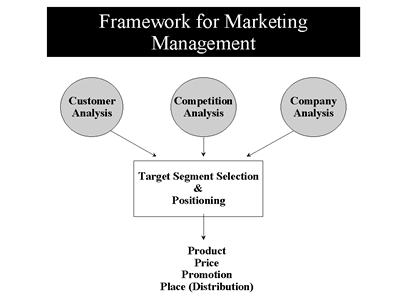What's the difference between marketing and sales? Or between marketing and advertising, or promotion?
The fact is that while lots of people think marketing is about advertising and other tactics, marketing is in fact much bigger than that. In fact, very good marketing is heavily based on analysis. In these articles we will show the analysis and the tactics that make up marketing.
Marketing a product or service consists of three essential stages. These are shown in the figure below.
FIRST STAGE
In the first stage of marketing, we conduct analysis. Three types of analysis should be performed: Analysis of customers, competitors, and the company marketing the product. In fact, other types of analysis can and should be done; for example, broad environmental and technological analysis is also an important part of doing powerful marketing. In this tutorial, however, we focus primarily on the so-called 3 C’s.
Some people believe that focusing squarely on customers is most important. Others, including Michael Porter and his disciples, believe that competitors are the most threatening aspect of any part of a company’s strategy and should be the focus of obsession. Still others focus on the company and its core competencies.
In fact, if you think about it, you really need to analyze all three and pay equal respect to all parts of the analysis. To see this clearly, just consider trying to market a product that you have researched and found would deeply satisfy customers. Is this enough information to warrant launching that product? Wouldn’t you want to know if your competitors could destroy your intentions? And wouldn’t you want to know if your company has the capabilities and motivation and maybe even culture to provide what customers want. No, all three parts of the analysis are important.
SECOND STAGE
After analysis, the next step is to make decisions about objectives. In marketing, this consists of deciding which customer segments to target and what is a sustainable and differentiable position to have in the minds of customers. This is essentially a decision about to whom and what benefits we should be promising and delivering. As you will see, these decisions, while deeply important, are easier to make if you have done proper analysis. My experience in the real world suggests that too many firms make these types of decisions without really doing any proper analysis.
THIRD STAGE
At this point we use the so-called 4 P’s (product, price, promotion, and place – otherwise known as distribution) to effect the proper positioning of the product. These are marketing tactics. Some people like to think of them as strategies. But these are more the things that get the job done (i.e., deliver the benefits) rather than the larger questions posed in prior stages. As before, there are literally hundreds of marketing tactics, but in choosing which ones to use, it is easier (and more correct) to base them on a sound analysis.

SOME COMMENTS
Notice that this framework, while ideal for a company that hasn’t yet developed a product, can be used by companies that already have developed products but want to position them correctly. Finally, pay heed to the following advice: Don’t let tactics drive strategy. That is, let the tactics follow from good strategic thinking based on a foundation of analysis.



